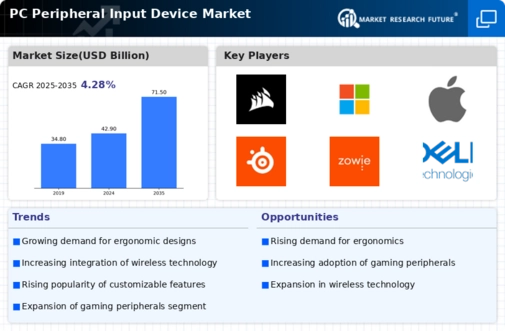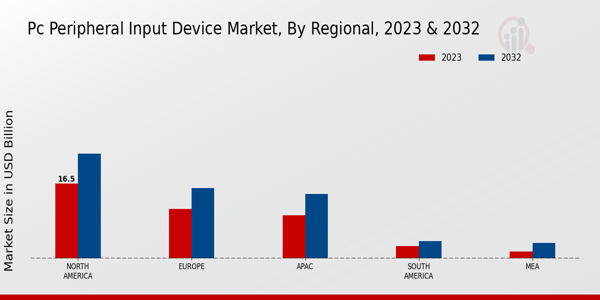Market Growth Projections
Rising Demand for Gaming Accessories
The Global PC Peripheral Input Device Market Industry experiences a notable surge in demand for gaming accessories, driven by the increasing popularity of eSports and gaming culture. As of 2024, the market is valued at approximately 42.9 USD Billion, reflecting the growing consumer interest in high-performance peripherals such as gaming mice, keyboards, and headsets. This trend is further supported by the proliferation of online gaming platforms and streaming services, which enhance user engagement. The gaming segment is projected to expand significantly, potentially contributing to the overall market growth as gamers seek advanced technology to improve their performance and experience.
Increased Focus on Ergonomics and Health
The Global PC Peripheral Input Device Market Industry is witnessing a growing emphasis on ergonomics and health-conscious designs. As awareness of the potential health risks associated with prolonged computer use rises, consumers are increasingly seeking input devices that promote better posture and reduce strain. Ergonomic keyboards, mice, and other peripherals are gaining traction among professionals and gamers alike. This shift not only addresses health concerns but also enhances productivity and comfort. Manufacturers are responding to this demand by innovating products that prioritize user well-being, thereby contributing to the overall growth of the market.
Growth of Remote Work and Online Learning
The shift towards remote work and online learning significantly influences the Global PC Peripheral Input Device Market Industry. As more individuals engage in telecommuting and virtual education, the demand for reliable and efficient input devices rises. Key peripherals such as webcams, microphones, and ergonomic keyboards are becoming essential for effective communication and productivity. This trend is expected to sustain the market's growth trajectory, with projections indicating a market value of 71.5 USD Billion by 2035. The increased reliance on technology for daily tasks underscores the importance of high-quality input devices, which are integral to enhancing user experience in remote environments.
Expansion of E-commerce and Digital Retail
The expansion of e-commerce and digital retail platforms significantly impacts the Global PC Peripheral Input Device Market Industry. As consumers increasingly turn to online shopping for electronics, the accessibility and availability of various input devices have improved. Retailers are leveraging digital platforms to reach a wider audience, offering a diverse range of products that cater to different consumer preferences. This trend is likely to drive sales growth, as evidenced by the projected compound annual growth rate of 4.76% for the period from 2025 to 2035. The convenience of online shopping, coupled with competitive pricing, enhances consumer engagement and boosts market performance.
Technological Advancements in Input Devices
Technological innovations play a pivotal role in shaping the Global PC Peripheral Input Device Market Industry. The introduction of features such as customizable RGB lighting, programmable buttons, and ergonomic designs enhances user experience and comfort. Companies are increasingly investing in research and development to create devices that integrate seamlessly with various operating systems and applications. For instance, the emergence of wireless technology and Bluetooth connectivity has transformed traditional input devices, making them more versatile and user-friendly. As these advancements continue, they are likely to attract a broader consumer base, thereby driving market growth and increasing the overall market valuation.














